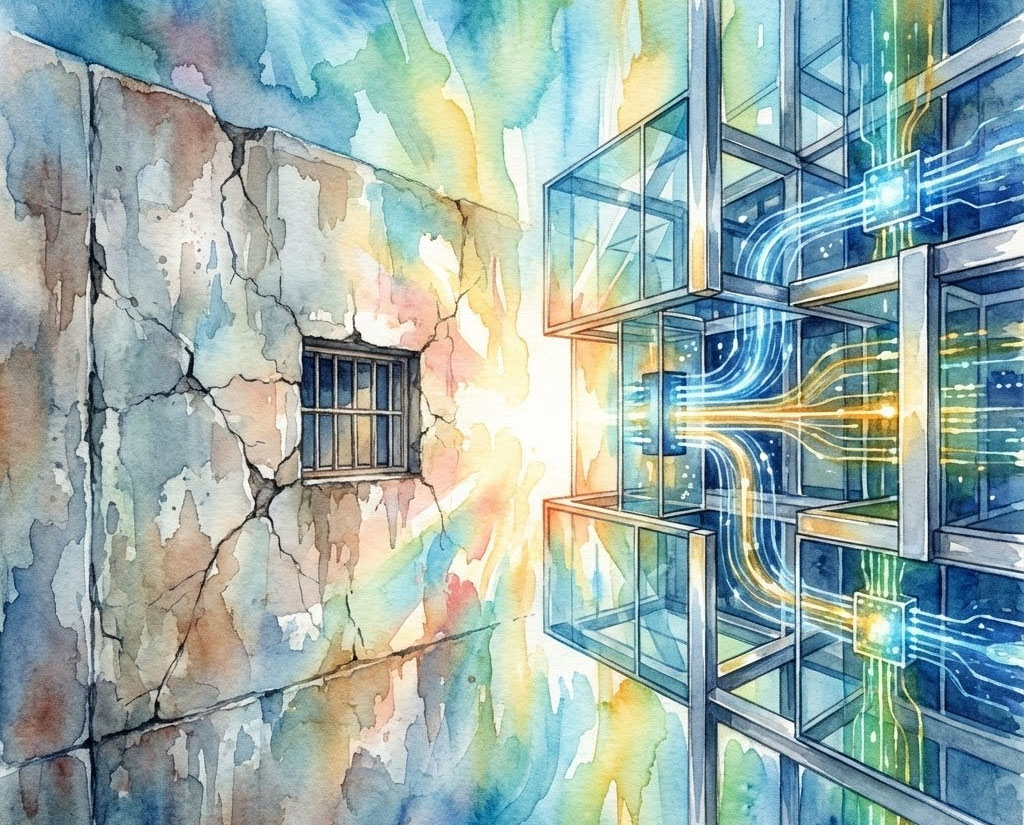
Infrastructure (buildings, roads, utility networks) as we know it, is inherently fragile. Presently, the most robust infrastructure is still subject the deterioration caused by time, use, weather. How might you produce an infrastructure system that is antifragile?
If you're not familiar with the term, antifragility is a concept developed by Nassim Nicholas Taleb (author of the popular book The Black Swan) which describes systems that improve through time and disorder.
In his own words: "Antifragility is beyond resilience or robustness. The resilient resists shocks and stays the same; the antifragile gets better."
The prospect is intriguing once you start applying it -- how, for instance, do you build structures that improve through time and shock? Well, you might want to encourage structures that build themselves.
...and how, exactly?
Nanobots. That’s how.
But before getting into that, let’s consider the Empire State Building. 86 years ago, 7 million person-hours went into the building of Empire State Building. Its concrete, marble, and steel are resistant to shock and time, but they are not antifragile. They, like most building materials, require maintenance. So far, maintenance and improvements to the Empire State Building total more than $1B US dollars along with thousands of additional person hours. As Rachel Maddow describes in her book Drift, construction is costly. But, maintenance is beastly: a never-ending, quiet war against time and the elements. You might say that it’s unfair to reference a building built in the ‘30s. Surely, infrastructure has evolved significantly in the last century?
We could consider the 1 World Trade Center or the Burj Khalifa, two of the tallest and most engineered buildings in the world: But, despite their profiles and prestige. These buildings are still only resilient, not antifragile. Like the Empire State Building, they are still, fundamentally steel, concrete, and glass. The tensegrity (tensional integrity) design elements utilized by the 1 World Trade Center are impressive manifestations of biomimicry, but they do not make the structure antifragile like many organisms and systems described by Taleb. These buildings require people, money, and other resources to maintain their integrity.
How might we flip this equation?
Structures designed from inorganic raw materials like steel, concrete, and glass will always require massive inputs. Time, energy, and resources. An inanimate structure is intensive because it’s very nature demands the rearrangement of substances in an unnatural and complex way that defies entropy.
How might infrastructure be designed to work with entropy?
Complexity and chaos theories dictate that complexity and order will foster a certain degree of vulnerability. Complexity theory also demonstrates that within enough disorder, a type of spontaneous organization will eventually emerge. This is at the core of antifragility and, too, is the core of self-organizing systems.
What does this have to do with nanobots?
Well, as exponential technology developments in artificial intelligence and robotics rewrite the rules every day (chaos and complexity), we cannot design structure for what we know today, or what we believe to know about tomorrow. We must design the systems of tomorrow upon the unforeseeable technological developments of the next decade (self-organization within complexity).
To paraphrase Heisenberg’s Uncertainty Principle: The more you know about momentum, the less you know about the position. The more you know about the position, the less you know about momentum.
In infrastructure design, this is to state: that if we are to design for the future (a position) we must design according to what we can determine in the present (momentum.) We cannot know the positions and conditions of the future, we can only attempt to incorporate the known components of momentum and velocity. For a demonstration of the quantum acceleration of cognition and design, there's an excellent article about the innovations that took place within the first moments of AlphaGo in its match against Lee Sedol.
While considering this, imagine the implications it will have upon the rudimentary nanobots demonstrated here. To put it simply, designing for the future means designing what doesn’t exist. This is an invitation to abandon the known. Abandon the practical.
Nanobots may be dancing little checkers that make simple shapes today, but they will be the building blocks of tomorrow. AlphaGo may be playing a board game today, but it will be orchestrating swarms of nanobots tomorrow. Wave-like systems describe the underlying ebb and flow that defines quantum mechanics, chaos theory, and emergent phenomena. Nanobots, AI, and quantum computing allow us to know that our infrastructure and systems will be dynamic and responsive. The ultimate synergy of these traits? Antifragility.
We simply need to design for that, one should not design limited to the known technology today. This means we can be inspired to match and surpass the fantastic predictions of science fiction authors like Neil Stephenson.
In The Diamond Age, Stephenson describes great, self-generating structures designed by nanobots known as “smartcoral”. Smartcoral is capable of:
“...extracting the necessary atoms directly from the seawater and the gases dissolved therein. The process looked chaotic, and in a way it was, but each lithocule knew exactly where it was supposed to go… they were tetrahedral building blocks of calcium and carbon…”
As fantastical as this sounds, it is entirely grounded in existing technology.
Read this to learn more about creating useful materials while sequestering carbon. Not only does this process remove greenhouse gasses from the air, this production method replaces the conventional, energy-intensive method of cement creation.
When you eliminate the need for human builders, you eliminate the need for shipping materials, and then the use of fuels in shipping and manufacturing, et cetera. This is an example of exponential impact for good, wherein solving one seemingly isolated problem cascades its solution effect in countless beneficial ways.
In order to ensure our best possible future, we have to imagine the impossible, and allow it to unfold before us. We need to trust and nurture new technology, and most importantly - never let the chorus of the current era's "can't be done" stand in the way of the next true breakthrough.







